Content
Yaskolka is a well-known herb used in landscape design. Its popularity is explained by its availability and unpretentiousness, while the decorativeness of this flower is very high. Planting and caring for perennial chickweed usually does not cause difficulties for gardeners, moreover, you can propagate this plant yourself.
Description of perennial chickweed
In the wild, the laskolka (lat.Cerаstium) is widespread; it can be found in the temperate zone of both hemispheres of the Earth. In addition, in the area of its distribution, the highlands of Africa and South America. The alpine variety that belongs to this family is the most northern flowering plant; in higher latitudes, only some algae, as well as mosses and lichens, are found. This perennial plant got its Latin name from the Greek word, translated as "horn", because of the characteristic shape of the fruit.
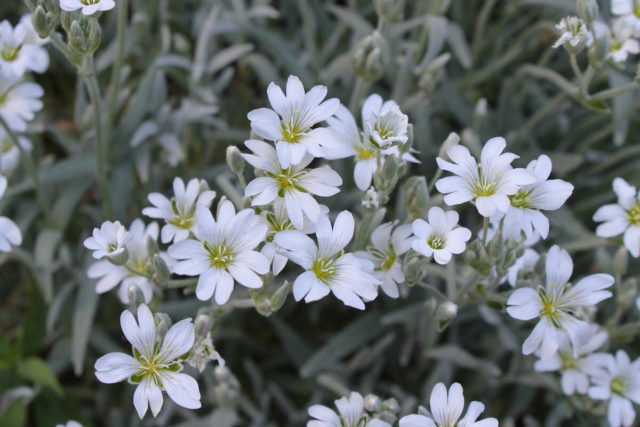
The chimney is easily recognizable by its flower petals.
Description and some characteristics of this plant are given in the table:
Parameter | Value |
A type | Perennial or annual herb. |
Family | Cloves. |
Escapes | Ascending or erect, sometimes creeping, green, even or slightly curved, pubescent in most species, easily rooting. |
General view of the plant | Dense sprawling curtain of a large number of shoots 0.1-0.3 m high. |
Leaves | Small, green, opposite, elongated-lanceolate, pubescent. |
Root system | Superficial, well branched, braiding. |
Flowers | Numerous, white, up to 2 cm in diameter, with 5 double-incised petals, corolla tubular, elongated. |
Seeds | Brown, small, curved, ripens in cylindrical capsule fruits |
Important! In nature, there are about 200 species of this perennial plant.
Blossoming period
The chrysalis blooms in a festive, amicable and abundant manner - the genetic adaptability of the species to a short summer in high latitude conditions is reflected. The first buds begin to appear closer to mid-May, and after a few days the bushes are completely covered with numerous white stars. The flowering of this perennial can last for about 1 month, until mid-June.
Types and varieties of yaskolka
Due to the abundance of species and varieties, such an unpretentious and visually attractive ground cover could not be ignored by landscape designers. Below are descriptions and photos of some of the varieties of jascolka, most often used by lovers of flowers and ornamental gardening, as well as recommendations for planting and care.
Ordinary
Common shingle (Cerаstium fontanum) is a perennial herb with ascending shoots 10-30 cm high. It grows quickly thanks to easily rooted creeping vegetative stems.Ground cover, forms a continuous dense carpet covering large areas. The leaves are small, green, with a silvery shade, oblong-ovate, with a short petiole. Flowers are white, numerous, appear at the ends of the shoots.
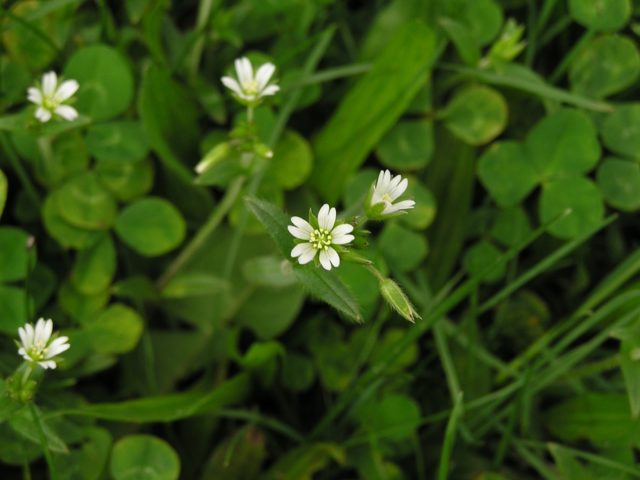
Common chickweed blooms in the second half of May
Bieberstein
Yaskolka Biberstein (Cerаstium bieberstеinii) is a species that occurs naturally only on the territory of the Crimean Peninsula. A perennial herb 15-25 cm high. The leaves are small, green, strongly pubescent, due to this they look like silvery, linear, pointed-elongated. The flowers are small, snow-white, gathered in semi-umbrellas at the ends of branched shoots. The flowering period lasts from late April to late May.
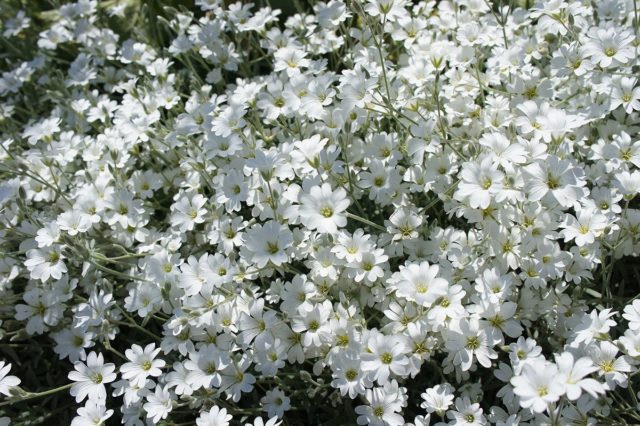
Jaskolka Bieberstein belongs to relict plants
Alpine lamb
In the photo below, alpine chickweed (Cerastium alpinum) is a herbaceous perennial, common in the alpine and subalpine belts of many mountain systems of the Northern Hemisphere. Stems are thin, creeping, well-rooted. The leaves are small, oval-ovate, pubescent, green with a silvery tinge. It grows in rocky cracks, under favorable conditions it grows rapidly, occupying significant areas. Blooms in May-June.
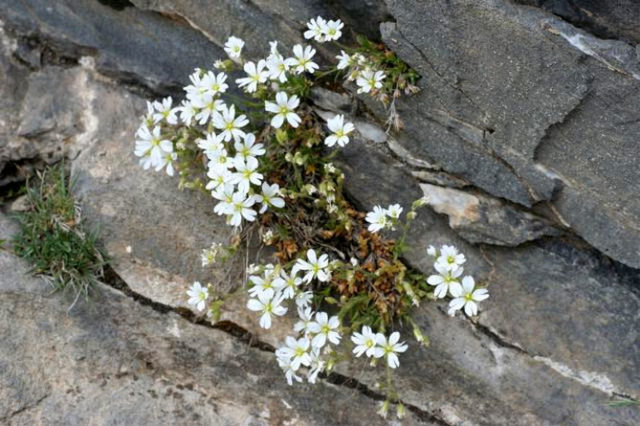
The northernmost variety of jascolka is alpine
Field shingle
Field shingle (Cerastium arvense) is considered a weed in many countries. Stems are numerous, erect. The leaves are small, green, pubescent. It grows rapidly, occupying large usable areas. Growing on agricultural land, perennial oppresses useful crops.
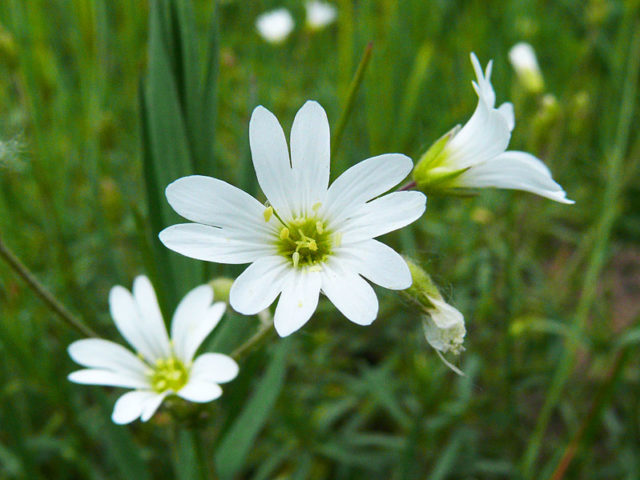
The field shingle quickly "sows" the soil
Felted
Felt chickweed (Cerastium tomentosum) is a herbaceous perennial, which got its name for the dense light pubescence of the leaves and stem. Shoots are even, erect, up to 45 cm. The leaf plates are lanceolate, elongated-curved. The inflorescence is a semi-umbrella, consisting of 15 white flowers located at the tips of the shoots. The buds begin to appear on the plant at the end of May.
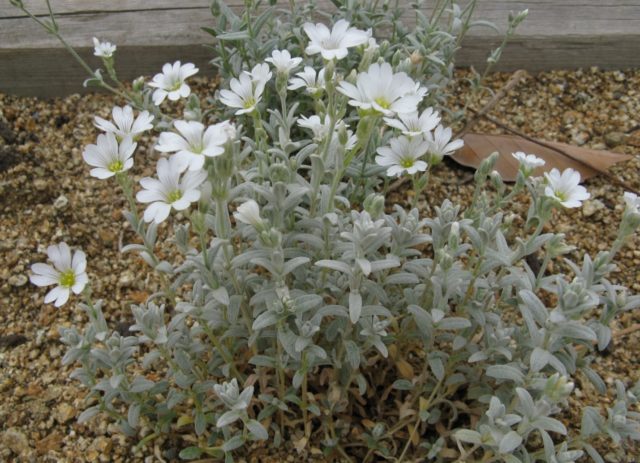
One of the most decorative types of chickweed is felt
Crystal waterfall
Crystal Falls is one of the most popular varieties of felt chickweed. It has leaves of an elongated lanceolate shape, abundantly covered with fine silvery hair. A perennial is often used for growing in a potted version. In warm temperate climates, it usually blooms twice during the season.
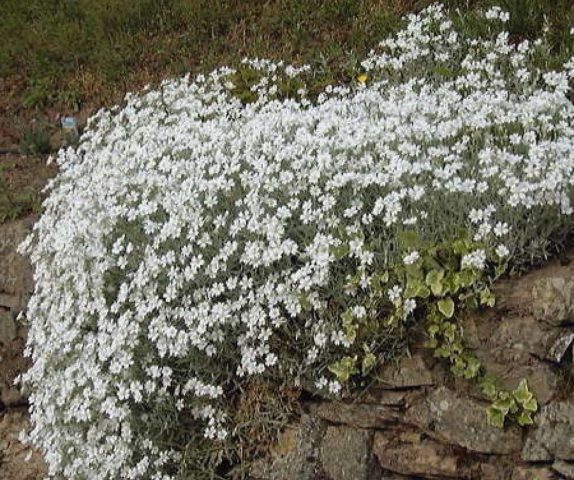
Crystal Falls are often used in various garden compositions.
Zhigulevskaya
Yaskolka Zhigulevskaya (Cerastium zhigulense) is a perennial endemic that grows only on the territory of the Zhigulevskaya Upland, a natural reserve of the Samara region. Has a powerful tap root system. Stems are highly branched, up to 30 cm, covered with fine hairs. Leaves are narrow-lanceolate, with a distinct central vein. The inflorescence is a sprawling semi-umbrella. The petals are white. Blooms in May-June.
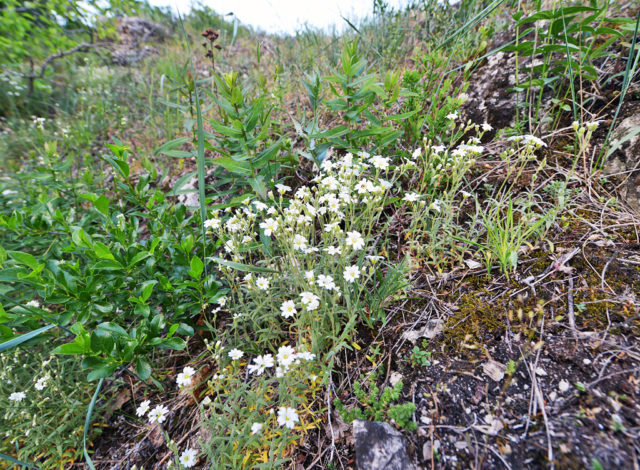
Yaskolka Zhigulevskaya grows rapidly, forming a dense cover
Daurskaya
Perennial dahurian chickweed (Cerastium davuricum) is found in the European part of Russia, as well as in the Caucasus, Siberia and Central Asia. It differs in rather significant size, the grooved stems of the plant can reach 1 m. The leaf plates are ovoid, the color is greenish-gray. The flowers are white, collected in half-umbrellas, appear in the middle of summer.

The Daurian variety of perennial chickweed can be found in Mongolia and China.
Fisher
Fischer's chrysalis (Cerastium fischerianum Ser) forms a dense curtain up to 0.5 m high, visually resembling a bluish-green cloud. Perennial. Stems are numerous, highly branched. The leaves are lanceolate. Flowers are small, numerous, white, appear in May.

From a distance, the curtain of laskolki resembles a thicket of chamomile
Purple
Purple chickweed (Cerastium purpurascens) is an indigenous inhabitant of mountainous slopes, you can find it in Turkey, Iran, the Caucasus, in the countries of the Middle East and Central Asia. Stems up to 0.25 m high, smooth, green. Leaves are greenish-gray, small, lanceolate. The flowers of this species of perennial chrysalis, contrary to the name, are white, medium-sized, appear in June.

Purple chickweed is found in the alpine belt of many mountain systems of Eurasia
Breeding chickens
The wild perennial chrysalis reproduces by self-seeding. In addition, the plant grows rapidly in breadth, rooting vegetative lateral shoots. If this species is already present on the site, then for independent cultivation in the garden, you can use any of such methods as dividing a bush or cuttings. The initial planting of this perennial plant can be done with seeds purchased from a gardening store or purchased over the Internet.
Growing from seeds
Growing chickweed from seeds at home takes quite a long time, so this method of reproduction is rarely used. It is advisable to use it if it is necessary to sow on large areas, as well as in the absence of the possibility of using other methods, when planting material can be purchased only in this form.
Cuttings
In June, after the appearance of well-developed new shoots, you can use them as cuttings for self-propagation of this perennial plant. Cut stems 10-15 cm high are rooted directly into the ground. They are buried in loosened moist soil 3-4 cm, and then covered with a cut plastic bottle on top, simulating greenhouse conditions. Cuttings have a good rooting rate if the procedure is carried out on time and in compliance with all requirements.
Dividing the bush
Dividing a bush is the easiest and most reliable way of self-propagation. Moreover, this procedure is beneficial for this perennial plant. It is recommended to divide the bushes once every 3-4 years, otherwise the curtain becomes too dense, the bush loses its decorative effect and stops blooming.

Dividing the bush significantly rejuvenates the plant
This procedure is carried out in the spring, before flowering. Previously, all old stems must be cut at a height of 3-5 cm from the ground and wait for young shoots to appear. After that, the curtain can be cut into several parts with a shovel. It is not necessary to shake the earth from the roots. Delenki are planted in a new place, after digging up and moistening the soil.
Planting and caring for the shingle
Chickweed seeds can be sown directly to a permanent place in the open ground, or previously grown seedlings from them. The first method is suitable for southern regions, where winters are short and mild. In the rest of Russia, it is better to use the seedling method.
When to sow chickweed for seedlings
The seeds of perennial chickweed have good germination. They germinate within 7-10 days after planting, so you don't need to sow them too early. The best time to plant seedlings from seedlings is late March or early April.
When to sow outdoors
In warm regions, seeds can be planted directly into the ground. This can be done in March, after the snow melts and the earth warms up. In addition, it is possible to plant chickweed in autumn, in October, as they say, "before winter". In this case, the planting material will undergo natural stratification and will give amicable shoots in the spring.
Soil and site requirements
Yaskolka is quite unpretentious and does not differ in exactingness to the cultivation technique, however, the correct choice of a place for planting it will significantly improve the general condition of the plants and increase their decorative effect, contributing to abundant flowering. Here are the basic requirements for the area where this perennial is supposed to be placed:
- Good sunlight.
- Loose, well-drained soil.
- Acidity close to neutral.
- No stagnation of water in the roots.

Large stones not only protect from the wind, but also keep warm
Perennial chickweed grows well even on stony soil, but in this case it may be deficient in moisture. This problem is solved by adding sand and peat that hold water well to the soil.
Planting chickweed seeds for seedlings
Any wide and shallow containers can be used for sowing chickweed seeds for seedlings, although it is preferable to do this in standard plastic cassettes. They are filled with soil purchased from a store or a mixture of soil and peat. The seeds are evenly distributed over the pre-moistened soil surface, and then slightly sunk in it. The container is covered with cling film and placed in a dark, warm place, where it will be until the first shoots appear.
How to dive a shard
After the emergence of shoots, the cover is removed from the container, while moving it to a lighted place. When the seedlings get stronger and the seedlings release the first pair of true leaves, they are dived in separate pots so that they do not interfere with each other. This is very easy to do with a regular metal spoon.
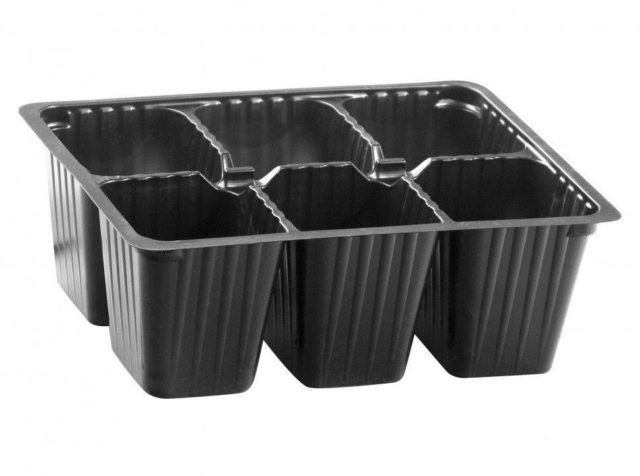
Initial planting of seeds in cassettes will eliminate the need to dive seedlings
The pots into which the pick is made are filled with the same soil, leaving planting holes in them. Seedlings from a group container are transplanted into them, along with a lump of soil on the roots. After that, the root zone is slightly compacted and irrigated with warm, settled water from a spray bottle.
How to fertilize seedlings and when to plant
Seedlings do not need a lot of nutrients. The usual seedling soil contains them in sufficient quantities, so you will not have to additionally feed the young plants. After the earth warms up, the seedlings are transplanted to a permanent place. By this time (end of April or the first half of May), the earth, as a rule, has time to warm up well.
Follow-up care
After planting in the open ground, perennial shrapnel does not require increased maintenance. As a rule, she has enough atmospheric moisture, so she does not need additional watering often and only during periods of prolonged drought. If the site is fertile, then it is not necessary to feed the plant; this may be required only if a perennial is planted on poor stony soil. In this case, it is better to feed it with a complex fertilizer for flowering plants. In this case, it is imperative to observe the amount of the introduced substance and its dosage.
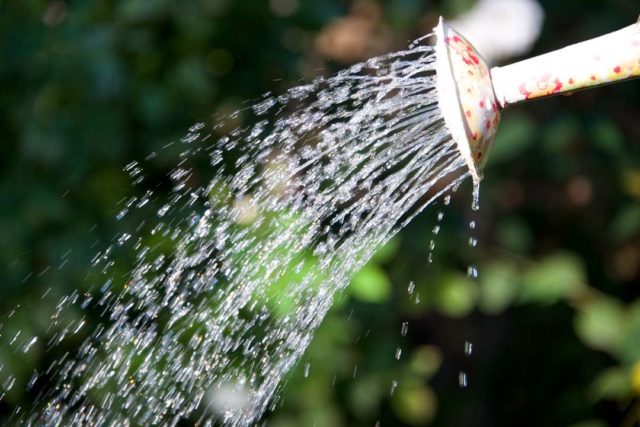
Waterlogging is detrimental to the perennial
Pruning is an important part of caring for perennial chickweed. It may be required if the plant needs to be kept in certain dimensions, not to allow it to creep. This is very important when planting in mixed flower beds, where a perennial can become a real aggressor and simply strangle neighboring plants. To prevent this from happening, lateral vegetative shoots must be regularly cut off. In addition, it is important to systematically remove wilted flowers, this contributes to the constant formation of new buds and an increase in the total flowering period of this perennial plant.
Below you can watch a video about growing delicate chickweed flowers from seeds:
Diseases and pests
Perennial chickweed does not suffer from the invasion of pests and is almost not susceptible to ailments, if you choose the right place for planting it.If the site is too shaded or excessively moist, then the plant will constantly hurt, and foci of rot may appear on it. This problem is solved only by transplanting to a more suitable place.
Yaskolka in winter
Yaskolka feels relatively well in winter, since it has good frost resistance. In many regions, this perennial plant can hibernate without shelter, especially when there is a lot of snow falling. If the winter is harsh and with little snow, then it is better to cover the bushes with non-woven material, for example, lutrasil.
Perennial yaskolka in landscape design
Perennial Yaskolka is one of the best ground cover plants. It is often planted as a substitute or alternative to the usual grass lawn. Expanding in width, the plant creates a solid carpet, or rather an airy blanket, which looks especially decorative during the flowering period.
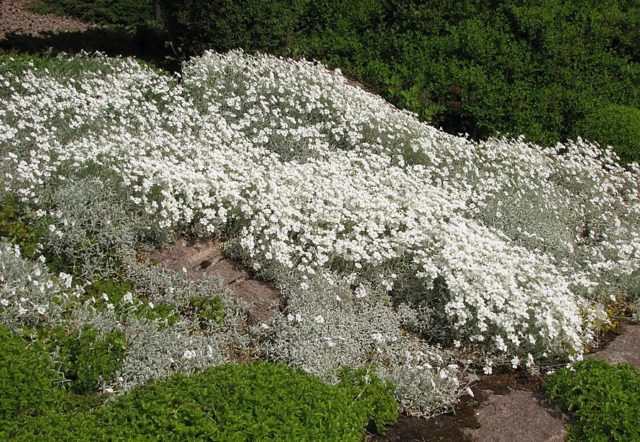
The chipped carpet perfectly hides the unevenness of the relief
Perennial chickweed, like cereal stellate, goes well with rocky terrain. Its landings neutralize sharp corners, fill in the folds, giving the relief softness and airiness. This property is used when planting in rock gardens and rockeries.
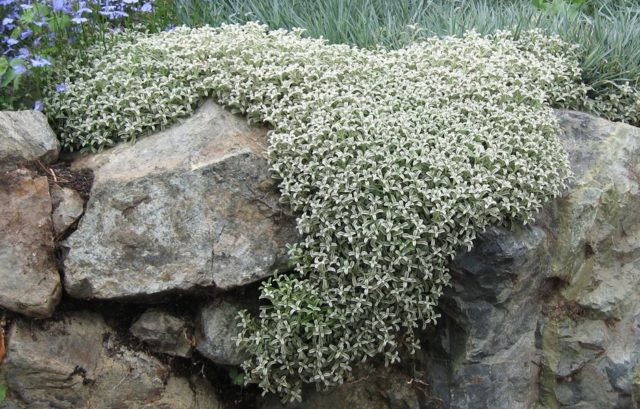
The plant perfectly masks cracks in stones
Perennial chickweed can be used for planting in a flower bed, as well as as a border plant. In this case, its growth is limited, preventing its spread to neighboring territories.

Chips make an excellent low curb
Perennial can be used as a decorative element when creating floral and architectural compositions, the plant looks good against the walls of buildings and large structures. In this case, it is planted with a solid carpet or separate curtains of irregular shape. White flowers of perennial laskolka are perfectly combined with pink, purple or lilac tones of other ground covers, for example, with gypsophila.
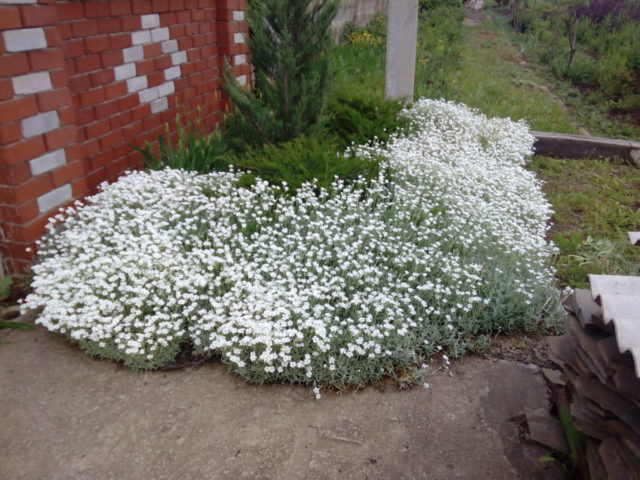
The rounded contours of the curtain give the landscape a calm tone
Conclusion
Planting and caring for perennial chickweed for the vast majority of gardeners will not cause any difficulties. However, it must be remembered that the constant uncontrolled growth of a bush can turn it from an ornamental plant into a weed. Without proper care, this perennial will very quickly creep over a large area, and it will not be easy to keep it in the required dimensions.








